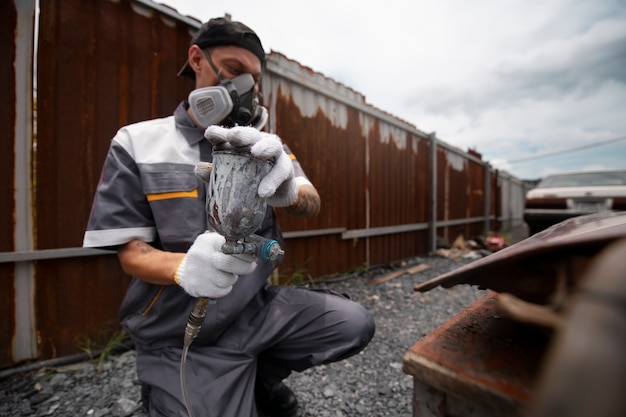Safeguarding Infrastructure: Cutting-Edge Corrosion Protection Solutions
Corrosion is a pervasive threat to infrastructure worldwide, causing substantial economic losses and posing significant safety risks. From bridges and pipelines to buildings and transportation systems, virtually every aspect of modern infrastructure is susceptible to corrosion. To mitigate this threat, innovative corrosion protection solutions have emerged, leveraging advanced materials and technologies to safeguard critical assets. In this article, we delve into the realm of cutting-edge corrosion protection solutions, exploring their efficacy and potential impact on infrastructure resilience.
Understanding Corrosion
The natural process of corrosion, commonly known as rust in metals, occurs when materials deteriorate as a result of chemical reactions with their surroundings. Corrosion is hastened by factors like moisture, oxygen, fluctuating temperatures, and pollutants, ultimately causing structural decay and eventual breakdown. Within infrastructure systems, corrosion presents itself through various manifestations such as the rusting of steel structures, the deterioration of concrete, and the erosion of pipelines.
The Cost of Corrosion
Corrosion has a significant economic toll, exceeding trillions of dollars globally each year. The direct expenses involve fixing and renewing corroded structures, while the indirect costs involve disturbances to transportation, utilities, and business operations. Additionally, corrosion-related malfunctions can lead to serious outcomes such as environmental pollution or even fatalities in extreme circumstances.

Traditional Corrosion Protection Methods
Throughout history, infrastructure proprietors have traditionally depended on standard methods for preventing corrosion, including coatings, inhibitors, and cathodic protection systems. Although these techniques have shown some effectiveness, they frequently fall short in terms of longevity, eco-friendliness, and cost-efficiency. As infrastructure grows older and environmental circumstances change, the demand for stronger corrosion prevention measures becomes more evident.
Cutting-Edge Solutions
Nanotechnology Coatings
The field of nanotechnology presents an exciting opportunity for combating corrosion by creating cutting-edge nanoscale coatings. These coatings, made from innovative materials like graphene and carbon nanotubes, offer enhanced protection against corrosion and superior barrier properties when compared to traditional coatings. Furthermore, these nanocoatings can be customized to suit different environmental settings, maximizing their effectiveness across a wide range of applications.
Smart Corrosion Sensors
Integration of smart sensors into infrastructure enables real-time monitoring of corrosion activity, facilitating proactive maintenance and intervention. These sensors utilize advanced technologies such as electrochemical impedance spectroscopy and wireless communication to provide accurate corrosion data remotely. By detecting corrosion at its early stages, infrastructure owners can implement timely interventions, prolonging asset lifespan and minimizing repair costs.
Composite Materials
Composite materials, reinforced with fibers such as carbon or glass, offer exceptional corrosion resistance and mechanical properties. Unlike traditional materials like steel or concrete, composites are immune to rust and degradation, making them ideal for harsh environments prone to corrosion. Applications of composite materials in infrastructure include reinforcement of concrete structures, fabrication of corrosion-resistant pipes, and construction of lightweight bridges.
Self-Healing Materials
Cutting-edge self-repairing materials have the incredible capability to fix small damages and fractures on their own, reducing the impact of corrosion as time goes by. These materials contain enclosed healing substances or tiny channels that break open when damaged, letting out healing agents to close up cracks and stop additional corrosion. Through the use of self-healing technology, infrastructure parts can uphold their strength and usefulness even in harsh corrosive conditions.
Environmental Considerations
While advancements in corrosion protection offer substantial benefits, environmental sustainability remains a critical consideration. Sustainable corrosion protection solutions prioritize eco-friendly materials, minimize energy consumption during manufacturing, and promote longevity to reduce lifecycle environmental impact. Additionally, proper disposal and recycling practices ensure that end-of-life infrastructure components do not contribute to environmental degradation.
Corrosion Mitigation Strategies
Cathodic Protection
Cathodic protection is a proven corrosion mitigation technique widely used in the protection of buried and submerged metallic structures such as pipelines, storage tanks, and offshore platforms. This method involves the application of a sacrificial anode or impressed current to polarize the protected structure and suppress corrosion reactions. Cathodic protection systems can significantly extend the service life of infrastructure assets, particularly in aggressive environments such as marine and industrial settings.
Inhibitors and Coatings
Corrosion inhibitors and protective coatings are essential resources in the fight against corrosion, providing an extra shield against environmental damage. Inhibitors work by creating a protective barrier on metal surfaces, preventing corrosion and prolonging the life of assets. Meanwhile, advanced coatings such as polymer-based, ceramic, and hybrid options offer robust defense against corrosion, abrasion, and chemical threats.
Advanced Corrosion Monitoring Techniques

Electrochemical Noise Analysis
Electrochemical noise analysis is a non-destructive technique used to monitor corrosion activity in real-time. By analyzing the electrochemical signals generated by corrosion processes, this method can provide valuable insights into the corrosion rate, mechanism, and severity. Electrochemical noise analysis is particularly useful for detecting localized corrosion phenomena such as pitting and crevice corrosion, allowing for early intervention and prevention of catastrophic failures.
Electrical Resistance Tomography
Electrical resistance tomography (ERT) is an imaging technique that utilizes electrical measurements to visualize changes in the internal structure of conductive materials, including those undergoing corrosion. By measuring electrical resistivity at multiple points, ERT can generate three-dimensional images of corrosion activity within infrastructure components such as pipelines and storage tanks. This non-invasive method enables comprehensive assessment of corrosion damage without the need for costly and time-consuming inspections.
Corrosion protection and management:
- Corrosion Under Insulation (CUI) Prevention: Implementing strategies to mitigate corrosion under insulation, including proper insulation design, selection of corrosion-resistant insulation materials, and regular inspection and maintenance to detect and address CUI early.
- Corrosion Monitoring in Harsh Environments: Utilizing specialized corrosion monitoring techniques, such as ultrasonic thickness measurement, in environments with high temperatures, pressures, or chemical exposures where conventional monitoring methods may be inadequate.
- Corrosion Management in Water Treatment Facilities: Employing corrosion-resistant materials and coatings in water treatment infrastructure to combat corrosion caused by aggressive water chemistry, biofouling, and erosion-corrosion from suspended solids.
- Corrosion Protection in Aerospace Applications: Applying advanced corrosion protection techniques, including chromate conversion coatings, anodizing, and protective coatings, to aerospace components exposed to harsh environmental conditions during flight operations.
6 Nicholas Drive Dandenong South, Vic 3175 Australia
Phone: 03 9768 2322

